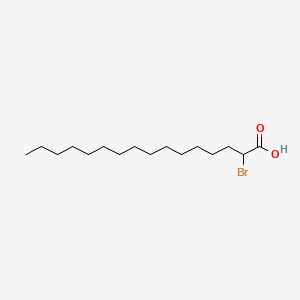| MeSH term | MeSH ID | Detail |
|---|---|---|
| Diabetes Mellitus | D003920 | 90 associated lipids |
| Body Weight | D001835 | 333 associated lipids |
| Carcinoma, Hepatocellular | D006528 | 140 associated lipids |
| Cardiomegaly | D006332 | 31 associated lipids |
| Hyperinsulinism | D006946 | 27 associated lipids |
2-bromohexadecanoic acid
2-bromohexadecanoic acid is a lipid of Fatty Acyls (FA) class. 2-bromohexadecanoic acid is associated with abnormalities such as Varicosity and Coronavirus Infections. The involved functions are known as Cell Proliferation, Apoptosis, Binding (Molecular Function), Regulation and Biochemical Pathway. 2-bromohexadecanoic acid often locates in Membrane, Cytoplasm, Mitochondria, Cell surface and Extracellular. The associated genes with 2-bromohexadecanoic acid are SLC33A1 gene, GRK6 gene, RBP1 gene, DST gene and FATE1 gene. The related lipids are Palmitates, Fatty Acids, Nonesterified Fatty Acids, Fatty Acids, Unsaturated and Oleates.
Cross Reference
Introduction
To understand associated biological information of 2-bromohexadecanoic acid, we collected biological information of abnormalities, associated pathways, cellular/molecular locations, biological functions, related genes/proteins, lipids and common seen animal/experimental models with organized paragraphs from literatures.
What diseases are associated with 2-bromohexadecanoic acid?
2-bromohexadecanoic acid is suspected in Varicosity, Coronavirus Infections and other diseases in descending order of the highest number of associated sentences.
Related references are mostly published in these journals:
| Disease | Cross reference | Weighted score | Related literature |
|---|
Possible diseases from mapped MeSH terms on references
We collected disease MeSH terms mapped to the references associated with 2-bromohexadecanoic acid
PubChem Associated disorders and diseases
What pathways are associated with 2-bromohexadecanoic acid
There are no associated biomedical information in the current reference collection.
PubChem Biomolecular Interactions and Pathways
Link to PubChem Biomolecular Interactions and PathwaysWhat cellular locations are associated with 2-bromohexadecanoic acid?
Visualization in cellular structure
Associated locations are in red color. Not associated locations are in black.
Related references are published most in these journals:
| Location | Cross reference | Weighted score | Related literatures |
|---|
What functions are associated with 2-bromohexadecanoic acid?
Related references are published most in these journals:
| Function | Cross reference | Weighted score | Related literatures |
|---|
What lipids are associated with 2-bromohexadecanoic acid?
Related references are published most in these journals:
| Lipid concept | Cross reference | Weighted score | Related literatures |
|---|
What genes are associated with 2-bromohexadecanoic acid?
Related references are published most in these journals:
| Gene | Cross reference | Weighted score | Related literatures |
|---|
What common seen animal models are associated with 2-bromohexadecanoic acid?
There are no associated biomedical information in the current reference collection.
NCBI Entrez Crosslinks
All references with 2-bromohexadecanoic acid
Download all related citations| Authors | Title | Published | Journal | PubMed Link |
|---|---|---|---|---|
| Holst D et al. | Nutritional regulation and role of peroxisome proliferator-activated receptor delta in fatty acid catabolism in skeletal muscle. | 2003 | Biochim. Biophys. Acta | pmid:12842194 |
| Dorfleutner A and Ruf W | Regulation of tissue factor cytoplasmic domain phosphorylation by palmitoylation. | 2003 | Blood | pmid:12920028 |
| Grimaldi PA et al. | Induction of aP2 gene expression by nonmetabolized long-chain fatty acids. | 1992 | Proc. Natl. Acad. Sci. U.S.A. | pmid:1438299 |
| Clore JN et al. | Evidence for dissociation of gluconeogenesis stimulated by non-esterified fatty acids and changes in fructose 2,6-bisphosphate in cultured rat hepatocytes. | 1992 | Biochem. J. | pmid:1445259 |
| Kovalenko OV et al. | Evidence for specific tetraspanin homodimers: inhibition of palmitoylation makes cysteine residues available for cross-linking. | 2004 | Biochem. J. | pmid:14556650 |
| Chen HQ et al. | Novel roles for palmitoylation of Ras in IL-1 beta-induced nitric oxide release and caspase 3 activation in insulin-secreting beta cells. | 2003 | Biochem. Pharmacol. | pmid:14563479 |
| Parker SM et al. | Palmitate potentiation of glucose-induced insulin release: a study using 2-bromopalmitate. | 2003 | Metab. Clin. Exp. | pmid:14564691 |
| Kausch C et al. | Skeletal muscle cells from insulin-resistant (non-diabetic) individuals are susceptible to insulin desensitization by palmitate. | 2003 | Horm. Metab. Res. | pmid:14605989 |
| Remizov O et al. | Palmitate-induced Ca2+-signaling in pancreatic beta-cells. | 2003 | Mol. Cell. Endocrinol. | pmid:14654245 |
| Gauthier-Campbell C et al. | Regulation of dendritic branching and filopodia formation in hippocampal neurons by specific acylated protein motifs. | 2004 | Mol. Biol. Cell | pmid:14978216 |
